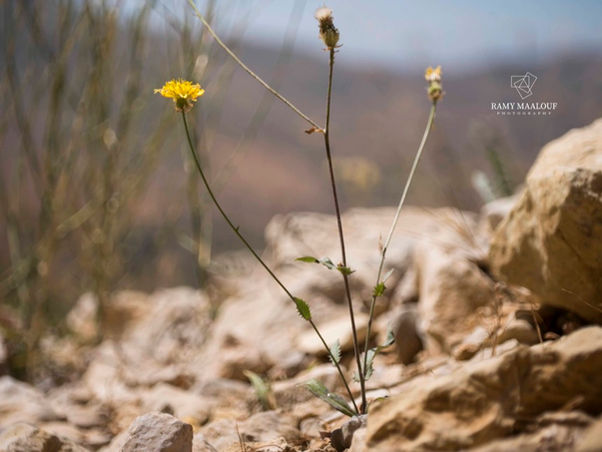Family |
Asteraceae
Crepis syriaca
(Bornm.) Babc. & Navashin
Crepis syriaca (Bornm.) Babc. & Navashin
(Bibliogr. Genet. 4: 75; 1930 – basionym: Crepis foetida subsp. syriaca Bornm., Beih. Bot. Centralbl. 31(2): 229; 1914 – Nouvelle Flore du Liban et de la Syrie, vol. 2, Pl. CCXVI nº 1; 1969)
• Life-form & habit: Annual to biennial herb, 15–50 cm tall, with erect, branched stems exuding milky latex. Whole plant sparsely hispid or glandular, often with a faintly foetid odour.
• Leaves: Basal leaves rosulate, oblong-lanceolate, 5–15 × 1–3 cm, pinnatifid to lyrate with obtuse or acute lobes; margins irregularly toothed. Cauline leaves alternate, smaller, sessile, clasping the stem with auriculate bases, entire or shallowly lobed.
• Inflorescence & flowers: Capitula numerous, arranged in loose corymbose panicles, each 15–25 mm across. Involucre narrowly campanulate, 10–14 mm long, with one outer series of shorter bracts and 2–3 inner series of longer ones, all linearlanceolate and sparsely hairy or glandular. Ligules yellow, sometimes tinged reddish beneath; florets 20–30, all ligulate. Receptacle naked.
• Fruit: Achenes 3–4 mm long, fusiform, slightly curved, brownish, 10-ribbed, smooth; pappus of numerous fine, white, scabrid bristles 5–6 mm long.
• Phenology: Flowers and fruits from March to June.
• Habitat & elevation: Dry rocky slopes, disturbed fields, and open steppe habitats on limestone or marl, 400–1 800 m; prefers full sun and moderately dry soils.
• Lebanese distribution: Recorded by Mouterde from Mount Lebanon and the Beqaa Valley — particularly Barouk, Dahr el-Baïdar, Zahlé, and Ras Baalbeck; widespread in the montane steppe belt and along rocky field edges.
• Native to: Lebanon, Syria, Palestine, Türkiye (POWO).
• ⚠️ Taxonomic note: Crepis syriaca is a Levantine endemic complex within the C. foetida group, distinguished by its glandular-hispid stems, strongly dissected basal leaves, and smaller, more numerous capitula. It differs from C. foetida subsp. foetida by its denser indumentum, shorter outer involucral bracts, and slender, often reddish peduncles. In Lebanon, it is common on dry montane pastures and limestone hillsides, sometimes forming large populations mixed with Scorzonera papposa and Lactuca orientalis.










